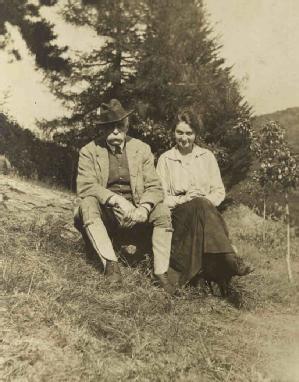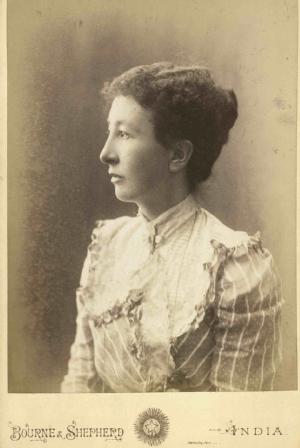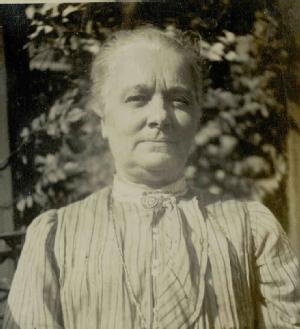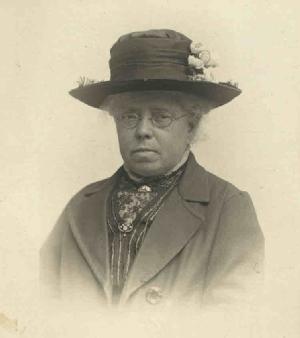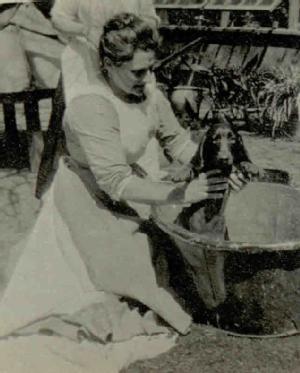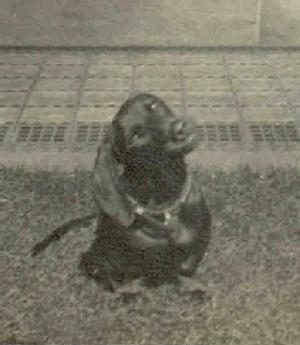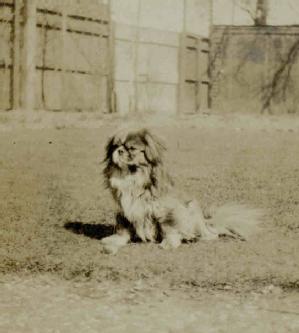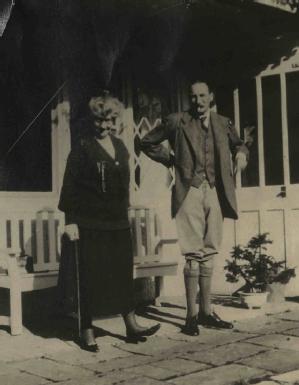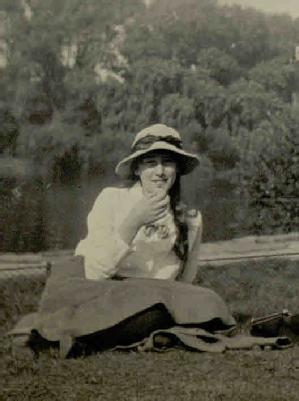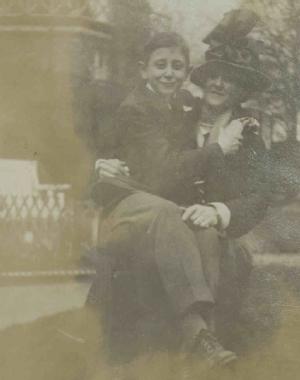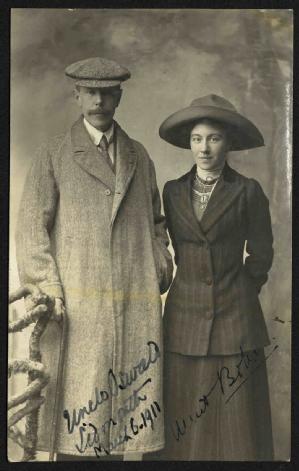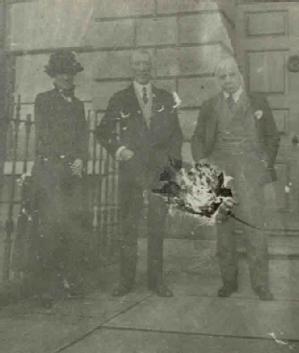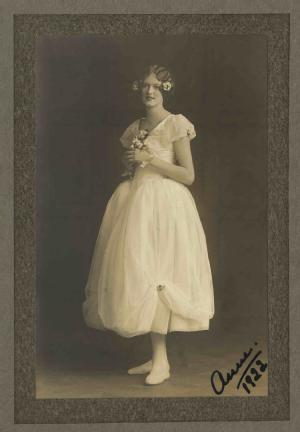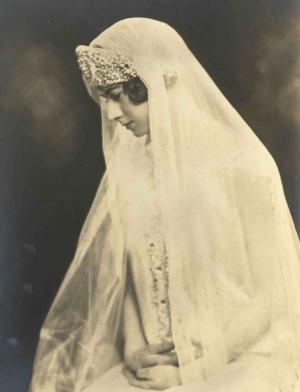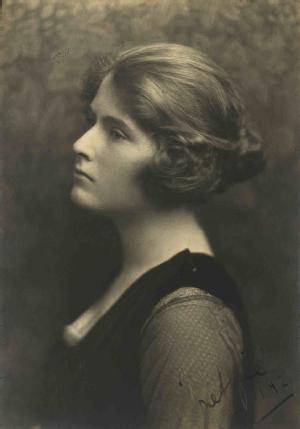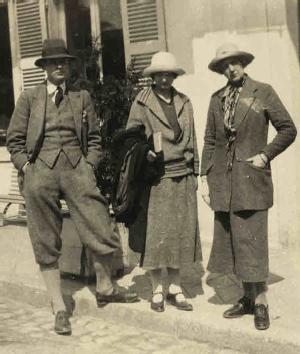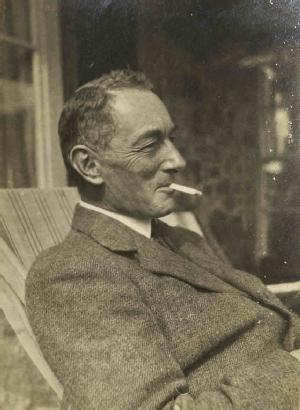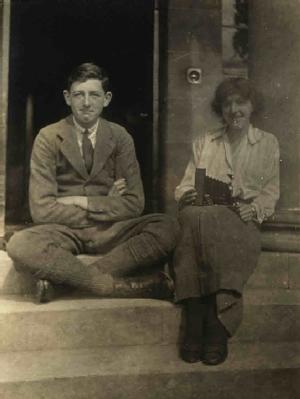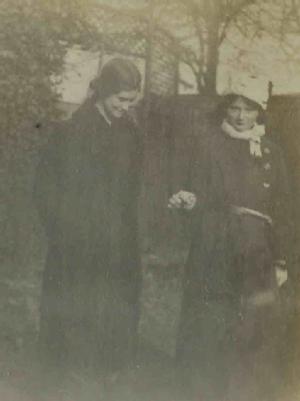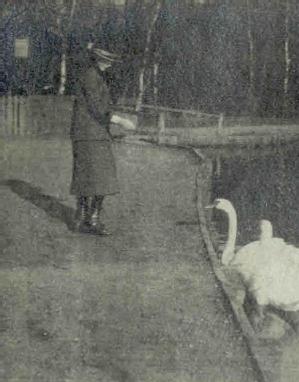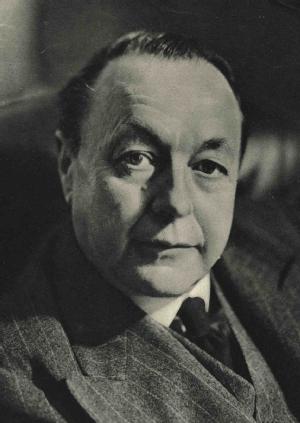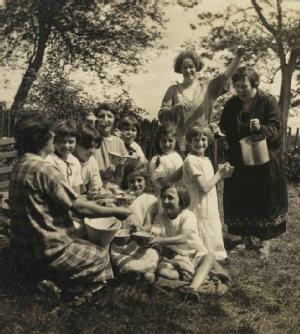Who's Who in the Younghusband diaries
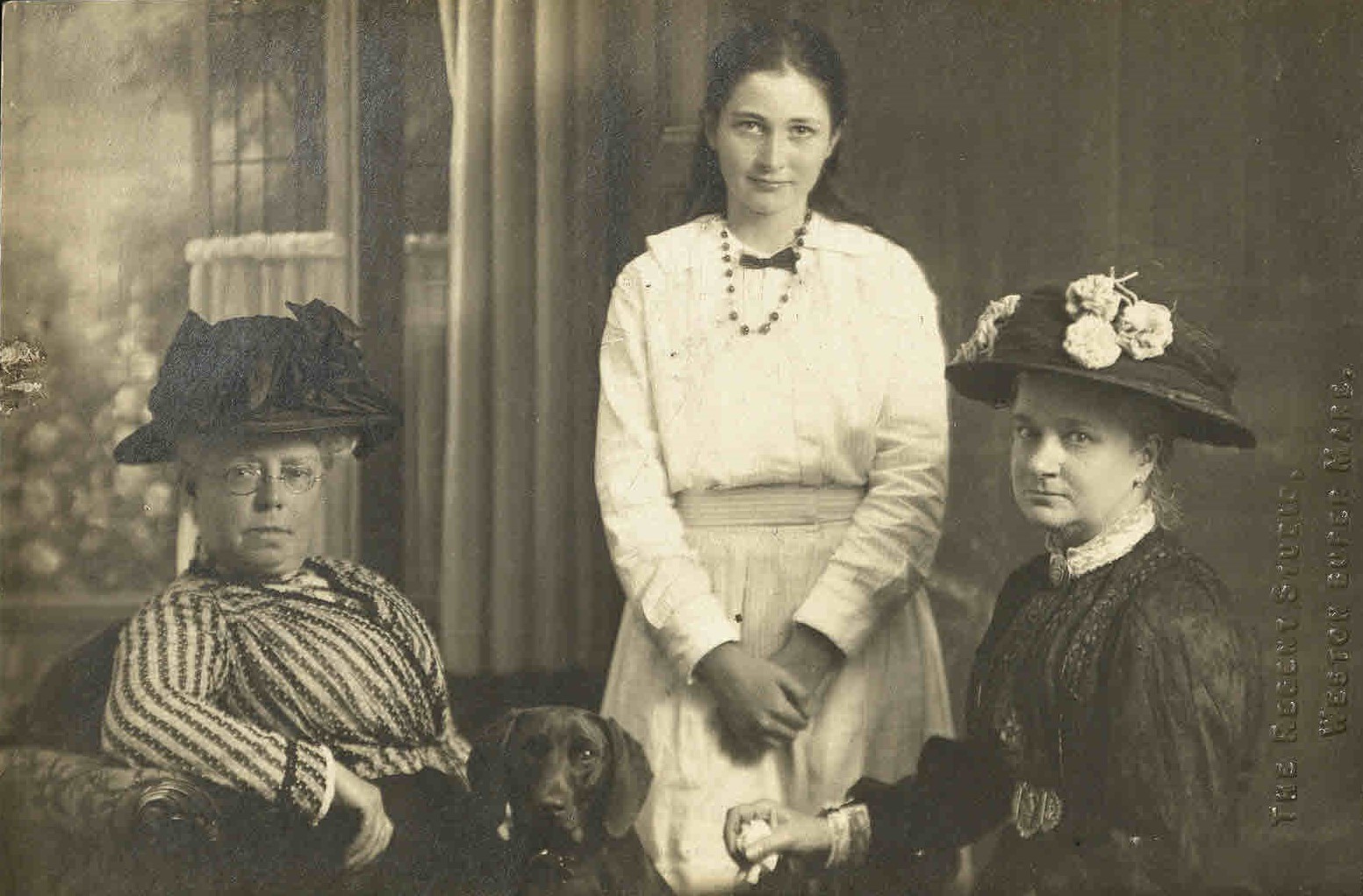
This guide provides brief biographical information about some of the more frequently mentioned individuals in Eileen Younghusband's 1917-30 diaries.
The entries have been compiled using the archives of Eileen Younghusband, including the papers of her biographer Kathleen Jones, online sources, including the British Newspaper Archive, the Times Digital Archive, Ancestry and Find My Past, and published biographies of Eileen Younghusband and Sir Francis Younghusband.
Immediate family and household
Daddie
Full name: Sir Francis Edward Younghusband (1863-1942)
Francis Younghusband's background was one of the military and Empire. He was born in Murree, India, in 1863, the son of Major John Younghusband and Clara Younghusband (sister of the explorer and diplomat Robert Shaw). Like his father and two brothers, Francis Younghusband joined the army and served in South Asia. Younghusband's early career involved exploration (including in Mongolia, across the Gobi Desert, the Himalayas and the Hindu Cush) and active participation in what the British termed the 'Great Game' - the military and diplomatic fight between Britain and Russia for imperial control over Afghanistan. In the early 1890s Francis Younghusband was transferred to the Indian Political Service and, whilst on leave between 1895-7, worked in India, South Africa and Rhodesia as a correspondent for The Times. In 1903-4 Younghusband headed the British invasion of Tibet ('Younghusband expedition'). He was condemned by the British government for exceeding his orders but received popular acclaim on his return to Britain.
In 1888 Younghusband was elected the youngest fellow of the Royal Geographical Society (aged 24) and served as President of the RGS between 1919-1922. As Chairman of the Mount Everest Committee, founded in 1921, he was instrumental in organising the British expeditions to Everest in 1921, 1922 and 1924.
After his permanent return from India to England in 1910, Sir Francis Younghusband moved from military and imperial service to developing ideas of nature-themed religious mysticism, merging elements of Eastern and Western religions into his own blend of spirituality which he promoted through publications and talks. He founded the World Congress of Faiths in 1936, with the intention of developing peace and fellowship between religions.
Francis Younghusband met Helen Magniac in 1897, during a shared voyage between South Africa and England, and they married later the same year. Their first child, Charles, was born in India in 1898 and died in infancy. Their second and only surviving child, Eileen Younghusband, was born in 1902.
By the 1920s Sir Francis Younghusband had begun to withdraw into his own thoughts and exhibit what Kathleen Jones, Eileen Younghusband's biographer, referred to as a "vagueness" when dealing with his immediate family. Neither Sir Francis or Helen Younghusband had the ability to manage a household on a budget and after 1923 (when "Daddie broke the cheerful news that we are broke", diary, 15 May 1923), Eileen Younghusband began to take a hand in the family's finances, effectively managing the household for her parents from the late 1920s until their deaths in the 1940s.
Books by Sir Francis YounghusbandLink opens in a new window available through the Internet Archive
Portraits of Sir Francis Younghusband available through the National Portrait GalleryLink opens in a new window
Oxford Dictionary of National Biography articleLink opens in a new window (subscription required)
Biographical information on WikipediaLink opens in a new window
Mummy
Full name: Helen Augusta Younghusband (1859-1945; previous surname: Magniac).
Helen Magniac was born in London in 1859, the daughter of Charles Magniac MP and Augusta Magniac (original surname: FitzPatrick). Augusta Magniac's first husband, Lieutenant-Colonel Thomas Vesey Dawson, had been killed during the Crimean War and she had two sons from her first marriage.
Helen Magniac was brought up in a wealthy, well connected and politically engaged family, the daughter of a financier and Liberal Member of Parliament and granddaughter (on her mother's side) of the Irish peer and Liberal politician Lord Castletown. Charles Magniac's bad investments in the stock market during the 1880s resulted in the loss of the family fortune and Chesterfield House, Magniac's Mayfair mansion, was sold after his death in 1891 to pay off his debts. She suffered from depression throughout her life.
"She was a person of very great courage and a good deal of intelligence and interest in the things which interested her. This was primarily the eighteenth century. ... My grandfather was a millionaire so she was brought up in great luxury but I think it was a very unhappy household from what contemporary relations told me, with my grandfather heavily over pressed by concerns in the City and my grandmother extremely neurotic."
"I had two parents who were highly incompatible from the point of view of a coherent family life for a child. He was interested in all that I was interested in ... . She didn't understand children and she was, I think, really pretty incapable of entering into the world of a child, so there was no companionship and very little communication between her and me. I think in some ways she was jealous of Shortie who, of course, played a far more important maternal role but, on the other hand, she didn't know how to do it and in some ways probably even didn't want to. ... She was increasingly shut out, with my father and me devoted to each other but with almost no involvement of her in our communication, our pleasures and our jokes. She was also apt to make strange, arbitrary decisions. ... I know that she used to open my letters and then shut them up again. At the time when I was being so-called prepared for Confirmation by Dick Sheppard, she said that I was not to see my great friend Peggy Leigh, during those months, because the implication was that Peggy was not a good influence. This was the kind of arbitrary decision she made and at that time I was eighteen or nineteen. But this was not something harsh or hostile. It was trying desperately to have some control in the situation, to do the right thing in my up-bringing. Her ideas were confined to girls being able to sketch and play the piano and dance and make good conversation." "She was nice to some of my friends but it was variable. LSE she hated. She always referred to it as that horrid place, but never by name." (reminiscences sent to Kathleen Jones, 1978/9).
Book by Helen YounghusbandLink opens in a new window available through the Internet Archive
Mrs Idie
Real name: Alice Woolford (c.1853-1929)
Lady's maid employed by Eileen Younghusband's mother. Nicknamed Mrs Idie for unknown reasons. Unmarried (the 'Mrs' was a title given in deference to her age and status). Alice Woolford became Helen Magniac's maid in 1884 (at Spa, Belgium) and remained with the family until her death in 1929.
In the earlier diaries, Mrs Idie divides her time between Sydney Place, Bath, (where the family furniture was) and the family homes. Mrs Idie's niece Alice Blyth and Alice's son Charlie Blyth are also referred to in the diaries.
Mrs Short / Shortie
Real name: Annie Higham (1860-1927).
Her nickname was given to her by Sir Francis Younghusband as the result of her diminutive height. Unmarried (the 'Mrs' was a title given in deference to her age and status).
Eileen Younghusband's nanny, surrogate mother and chaperone. Joined the family in c.1907 and remained with them until her death twenty years later. Mrs Short was originally from Streatham and also had family in Bermondsey, near the Princess Club. Mrs Short's previous 'baby' Marjory Hamilton, her sister Alice (d.1920) and her nephew are sometimes mentioned in the diaries. Mrs Short continued to chaperone Eileen Younghusband to social events, on shopping trips and on public transport when Eileen was in her late teens and early twenties, at an age when other contemporaries were allowed out on their own.
"There was a good deal of rivalry between Shorty and Mrs Idie, although they were also great friends, but Shorty of course sided with me and promoted primarily my interests and Mrs Idie very naturally promoted my mother's interests. ... They were largely the continuity and the backbone of life for a long time" (interview with Kathleen Jones, 1978/9).
"In the nineteen twenties it seemed very odd that Shortie always took Eileen to a party and came again at the end to take her home, but no doubt Lady Younghusband remembered her own girlhood, although the substitute for a 6 ft (minimum) footman was, by necessity, replaced by a 4' 11" Shortie." (recollections of Kathleen Lutyens, early 1980s).
Mrs Simpson
Family servant, possibly housekeeper. Had been with the family in Bath, during Eileen Younghusband's childhood, and remained with the family throughout the period covered by the diaries.
Childhood pets
Joffie
Eileen Younghusband's favourite. A dachshund named after the French General Joffre, born 20 September 1914. Eileen Younghusband was separated from him when the family moved from Wimbledon to their flat in London in February 1919 (Chi Chi remained with the family). Joffie spent three years in Bath and at the home of Aunt Alys and Uncle Romer, and then returned to the family home when the Younghusbands moved to Westerham in 1922.
Chi Chi
A pekinese, described by Eileen as "very pretty and almost more silly and hates me", a month older than Joffie. Stayed with Miss Wolff in 1920, whilst the family were in Belgium.
Polly
Grey parrot given to the family by the brother of the Maharajah of Kashmir in c.1909. Was loaned to the Milnes at Wimbledon after the Younghusbands moved to Warley Place in 1918.
Family
Aunt / Cousin Alys and Uncle / Cousin Romer
Romer Edward Younghusband (1858-1933) and Alys Maud Lavinia Younghusband (1865-1954; original surname: Barratt).
'Uncle' Romer was a cousin of Sir Francis Younghusband. Romer and Alys Younghusband lived at the Old Rectory, Woolverton, Somerset.
After graduating from Oxford, Romer Younghusband was called to the bar and went to India in 1879. During a 30 year career in the Indian Civil Service he held a variety of posts, including Political Officer, Judicial and General Secretary to the Punjab Government, Commissioner of Lahore and Member of the Punjab Legislative Council. He retired in 1909, coming out of retirement during the First World War to serve as a Major in the Royal Army Service Corps. He was a member of Somerset County Council between 1922-5 and was heavily involved with the local church and Conservative Party.
Aunt Alys and Uncle Romer looked after Joffie, Eileen Younghusband's dog, in 1920.
Cousin Cecil
Aimee Cecil Romer Armitage (1884-1968; original surname: Younghusband).
Daughter of Sir Francis Younghusband's cousin George Younghusband (1856-1897) and Aimee Younghusband (1858-1951, known as Aimee Brazier-Creagh after her second marriage in 1909). Married Lieutenant-Colonel Arthur Glanville (1866-1906) in 1905 and Colonel Edward Armitage (1859-1949) in c.1908. Had a son Peter (Edward Francis Peter Armitage) from her second marriage. Also referred to as just Cecil.
Set up as an advisor on house decorating in 1920. Opened a shop at Chester Lodge, Chester Mews, London, in 1922 (in 1922 it sold antiques, in 1924 electric light fittings).
"Like an oasis in the desert, Cecil very full of life and stories" (diary, 17 December 1924).
Uncle Claude and Aunt Di
Claude Hollingworth Magniac (1863-1931) and Diana Geraldine Vere Magniac (1866-1956; original surname: Macdonald).
Claude Magniac was a brother of Eileen Younghusband's mother and worked as a stockbroker in the City of London. Uncle Claude and Aunt Di lived at Ashtead, Surrey, and were Eileen's favourite aunt and uncle. Their occasionally violent dog Timmy also makes several appearances in the diary.
Information about Aunt Di (including a portrait) is available through a Brighton Museums blogLink opens in a new window
Cousin Con Parker
Constance Parker (1858-1937; original surname: Barkley).
Distant relation of Eileen Younghusband. Born in Turkey, where her father, John Trevor Barkley, was an engineer involved in the construction of railways in the Ottoman Empire. Married to Robert John Parker (1857-1918), Baron Parker of Waddington, High Court judge. Lived in Haslemere, Surrey.
Several of her children, Trevor, Gwen, Jack and Hubert Parker are also mentioned in the diaries and are sometimes also referred to as cousins.
Biographical information about Robert Parker on WikipediaLink opens in a new window
Biographical information about Hubert Parker on WikipediaLink opens in a new window
Uncle Dick, Aunt Venetia, Gilbert, Patsy and Nina
Richard John Edward Meade (1871-1957), Helen Venetia Digby Meade (1864-1944; original surname: Newbolt) and their children Richard Gilbert Trevor Meade (1895-1917), Patricia ("Patsy") Helen Isabel Meade (1899-1976) and Ulrica ("Nina") Elizabeth Meade (1902-1964).
'Aunt' Venetia was a cousin of Eileen Younghusband's mother. The Meades lived at Croxton, Norfolk.
Richard Meade was land agent for the Earl of Albemarle - "he must have been very badly paid, they were extremely poor and, well, I think people in those days did to some extent rejoice in genteel poverty" (interview with Kathleen Jones, 1978/9). Gilbert Meade was killed on 10 October 1917 whilst on active service in Mesopotamia.
Eileen Younghusband stayed with the Meades at Croxton in 1923. Nina Meade sailed with Cousin Toby to join Cousin Vallie in South Africa in 1924.
Commonwealth War Graves Commission entry for Gilbert MeadeLink opens in a new window
Uncle Douglas and Aunt Aimée
Brigadier-General Sir Douglas Frederick Rawdon Dawson (1854-1933) and Aimée Evelyn Dawson (1864-1946; original surname: Pirie, had previously been married to Herbert Oakley). They adopted a daughter, Rosemary, in 1919.
Uncle Douglas was a half-brother of Eileen Younghusband's mother. The Dawsons moved from Medmenham Abbey, Buckinghamshire, to Remenham Place, Henley on Thames, in 1920.
Douglas Dawson joined the Coldstream Guards at the age of 20 and saw active service in Egypt during the 1880s. Between 1890-1901 he was Military Attaché at Vienna and Paris and then became a courtier to Edward VII and George V, as Master of Ceremonies (1903-1907), Comptroller in the Lord Chamberlain's Department (1907-1920), and State Chamberlain (1920-1924). During the First World War he served in the War Office (1914-5) and as Inspector of Vulnerable Points (1916-19). He was also a director of the City Equitable Fire Insurance Company, a company which collapsed due to the fraud of its chairman Gerard Lee Bevan in 1925.
"Uncle Douglas was very grand... it was all very formal indeed and I didn't really enjoy staying there" (interview with Kathleen Jones, 1978/9).
Portraits of Sir Douglas Dawson available through the National Portrait GalleryLink opens in a new window
Biographical information about Sir Douglas Dawson on WikipediaLink opens in a new window
Cousin Florrie
Florence Ella Liddell (1870-1942; original surname: Magniac).
Florence Liddell was a cousin of Eileen Younghusband's mother and sister to Aunt / Cousin Mabel, Cousin Tottie and Aunt Vallie. She was married to Lionel Charles Liddell (1868-1942), younger brother of Sir Frederick Francis Liddell (husband of Aunt / Cousin Mabel) and Alice Liddell (of 'Alice in Wonderland' fame).
Aunt Geraldine, Uncle Raymond and Cynthia
Raymond Sudeley Webber (1866-1942), Sybil Aimée Geraldine Webber (1874-1952; original surname: Magniac), and their daughter Cynthia Kathleen Augusta Webber (1904-1985).
Aunt Geraldine was a sister of Eileen Younghusband's mother.
Lieutenant-Colonel Raymond Webber had been an officer in the Royal Welsh Fusiliers and His Majesty's Bodyguard.
In 1929 Cynthia Webber married George Price in a registry office ceremony, to the subsequent dismay of her parents ("There is great agitation about Cynthia Webber who has run away & married a penniless & jobless youth at a registry office without telling her people", 21 September 1929).
Portrait of Geraldine Webber available through the National Portrait GalleryLink opens in a new window
Uncle Holly
Captain Hollingworth Brian Magniac (1867-1932)
Uncle Holly was a brother of Eileen Younghusband's mother.
During the mid-1920s he managed a salmon fishery in the north of Scotland and was estate agent for Lord Tredegar at the time of his death.
Uncle Jack / Uncle George, Aunt Madelaine and George
Major-General Sir George John Younghusband (1859-1944), Madelaine Younghusband (1861-1952; original surname: Wood), and their son George Edward Younghusband.
Uncle Jack was a brother of Eileen Younghusband's father.
Sir George Younghusband joined the army in 1878 and saw active service in Afghanistan, India, Sudan, Burma, South Africa and the Middle East, and also fought on the American side in the Spanish-American War. He was invalided home from Mesopotamia in 1916 and was appointed Keeper of the Jewel House in the Tower of London in 1917. Eileen Younghusband visited the family on several occasions in the Tower of London. George E. Younghusband also joined the army and was stationed in India with the 11th Hussars during the 1920s.
Books by Sir George Younghusband available through the Internet ArchiveLink opens in a new window
Portraits of Sir George Younghusband available through the National Portrait GalleryLink opens in a new window
Biographical information on WikipediaLink opens in a new window
Aunt Kathleen, Uncle Leslie, Ian and Laurie
Kathleen Elizabeth Caroline Younghusband (1873-1942; original surname: Bott), Leslie Napier Younghusband (1866-1939) and their children John Leslie (Ian) Younghusband (1899-1966) and Laurence (Laurie) George Short Younghusband (1903-1982).
Uncle Leslie was a brother of Eileen Younghusband's father.
Leslie Napier Younghusband joined the army in 1885 and was appointed to the Indian Staff Corps in 1887. He also saw active service during the Boer War and in Mesopotamia during the First World War. He retired in 1921. Ian Younghusband was in the navy during the First World War.
Uncle Len, Aunt Ethel and Robin
Rev. Arthur Leonard Harrison (1862-1918); Ethel Harrison (c.1861-1944; original surname: Younghusband), and Alick Robin Walsham Harrison (1900-1969)
Aunt Ethel was a sister of Eileen Younghusband's father. Two sons - Leonard John Harrison and Gerard Younghusband Harrison - were killed during the First World War.
Uncle Len was a Church of England clergyman who had worked in the benefices of Haslemere, Surrey; Burton, Pembrokeshire; Walsham le Willows, Suffolk; and Yelverton, Norfolk. Robin Harrison was at the private school Haileybury, Hertfordshire, and Merton College, Oxford, during the earlier diaries. He subsequently became an academic, teaching ancient history at Merton College, Oxford.
Biographical information about Robin Harrison on WikipediaLink opens in a new window
Commonwealth War Graves Commission entry for Leonard HarrisonLink opens in a new window
Commonwealth War Graves Commission entry for Gerard HarrisonLink opens in a new window
Aunt Lil / Lil Macdonald
Christiana "Lily" Blanche Ashworth Macdonald (1866-1947)
Twin sister of Diana Magniac (nee Macdonald), Eileen's Aunt Di. Eileen Younghusband stayed with her in London in 1927, and saw her when staying with Uncle Claude and Di.
Biographical information about Lily Macdonald (including portraits and accounts of supernatural experiences) available through a Brighton Museums blogLink opens in a new window
Lilac Porteous
Lilas May Porteous (1896-1969), daughter of David Scott Porteous and Flora Porteous (original surname: Macdonald) of Lauriston Castle, Montrose, and sister of Phyllis Porteous. Mr and Mrs Porteous and Phyllis are also mentioned in the diaries. A niece of Aunt Di.
Often referred to only as Lilac (rather than Lilas). Lilas Porteous married (William) Simon Campion in 1921 (Eileen Younghusband was a bridesmaid). A previous engagement in 1919 had been broken off. In 1924 Simon Campion lost his memory of everything that had happened since 1919 (he "remembers nothing since 1919, not even that he is married and has a son", diary, 20 May 1924), a loss linked to post-traumatic stress disorder following the First World War. Lilas and Simon Campion separated in 1926 and divorced in 1938.
Aunt / Cousin Mabel, Uncle / Cousin Eric, Harry, Julian, Maurice and Bridget
Mabel Alice Liddell (1869-1959; original surname Magniac), Sir Frederick Francis ("Eric") Liddell (1866-1950), and their children Harry, Julian, Maurice and Bridget. Also referred to as the Culford Garden Liddells.
Mabel Liddell was a cousin of Eileen Younghusband's mother ("she was a favourite so she became Aunt", interview with Kathleen Jones, 1978/9), and sister to Cousin Florrie, Cousin Tottie and Aunt Vallie. Eric Liddell was a brother of Lionel Charles Liddell (husband of Cousin Florrie) and Alice Liddell (of 'Alice in Wonderland' fame). They visited the 'Miss Liddells' in Westerham (Eric Liddell's sisters) on various occasions.
Eric Liddell qualified as a barrister and in 1895 began working in the Parliamentary Counsel's office, drafting legislation. He was First Parliamentary Counsel between 1917-1928 and Counsel to the Speaker of the House of Commons from 1928-1943.
"Maurice's stunt at moment is Communism strongly flavoured with an appreciation of literature & art in consequence of which he wears brown suede shoes & a light fawn hat with a very wide brim" (diary, 16 January 1925).
Biographical information about Sir Frederick Liddell on WikipediaLink opens in a new window
Commonwealth War Graves Commission entry for Julian LiddellLink opens in a new window
Cousin Margaret
Margaret Magniac.
Margaret Magniac ran St Martin in the Fields Women Workers' Club, London, which included a canteen to provide subsidised meals. Eileen Younghusband volunteered at the club between 1920-1922, and obtained advice from Margaret Magniac about her subsequent voluntary work.
Uncle Oswald, Aunt Bobs, Joan, Tony and Anne
Oswald Cecil Magniac (1862-1939), Florence Alice Magniac (1884-1947; original surname: Blandy) and their children Joan (b.1915), Anthony Charles Oswald Magniac (1919-1941), and Alice Cecilia Anne Magniac. Tony is also referred to as John.
Uncle Oswald was a brother of Eileen Younghusband's mother. Florence 'Bobs' Magniac was a daughter of John Blandy, wine producer in Madeira. The Magniacs lived at Grove Place, Nursling, and Tilney Street, London.
Oswald Magniac was a Director of Humphrey & Grey (Lighterage) Ltd. (owners of Hays Wharf, London), and a member of the Board of the London and County Bank. He was a 'Younger Brother' of the maritime corporation and charity Trinity House, a Governor of Guy's Hospital and involved in charity fundraising for other London hospitals.
A family argument over the ownership of the family "pictures" led to Helen Younghusband temporarily banning Aunt Bobs from seeing her daughter (Eileen Younghusband discovered this in February 1920, some months after the ban had been imposed). Eileen Younghusband holidayed with the family on their yacht 'Rosalind' on the Solent and on the Isle of Wight in 1924.
Cousin Tottie / Cousin Toby
Beatrice Evelyn Sullivan (1868-1936; original surname Magniac).
Cousin of Eileen Younghusband's mother and sister of Aunt Vallie, Cousin Florrie and Aunt / Cousin Mabel. Married to Commander Richard Sullivan of the Royal Navy.
Beatrice Sullivan was referred to as Cousin Tottie until 1924. After some negotiation, the nickname was changed from Tottie to Toby as "Cousin Dick didn't approve of the younger generation calling her by that name" (diary, 25 July 1924). Eileen Younghusband saw Cousin Tottie / Toby on various occasions, including in 1921 and 1924 before she travelled to join her sister Vallie in South Africa (Nina Meade also sailed with her in 1924).
"Just the same, very lively and talks without ceasing at the top of her voice" (diary, 18 July 1924).
Cousin V, Cousin Eddie and the Tighes
Captain Edward Kenrick Bunbury Tighe (1862-1917), Viola Lilian Henriette Tighe (1871-1941; original surname: Skeffington Smyth) and their children Kathleen Augusta Louisa Tighe (1897-1976), Oonah Frances Geraldine Tighe (1900-1967), (Gertrude) Moyra Florence Tighe (1903-1992), Shelagh Beatrice Aimee Tighe (1909-1997) and Brian Francis Kenrick Tighe (1913-1940).
Captain Tighe was a cousin of the Earl of Bessborough, director of several Irish railway companies and former High Sheriff of Kilkenny. In 1896 he had stood for election as a Conservative Party candidate in the parliamentary constituency of North West Norfolk, but was defeated by the trade union leader Joseph Arch. He had retired from the Rifle Brigade owing to ill health.
The Tighes, distant relations of Eileen Younghusband, moved to Winkfield Lodge, Wimbledon, in November 1917. 'Cousin Eddie' was killed by an intruder days after they had moved into the house. Sir Francis Younghusband stayed at the Lodge in the nights immediately following the attack and gave evidence at the inquest. Eileen Younghusband became friendly with the children after Captain Tighe's death. The family later moved to Lingfield.
Commonwealth War Graves Commission entry for Brian TigheLink opens in a new window
Aunt Vallie / Valley
Full name: Valentine Isabel Magniac (1873-1945).
A cousin of Eileen Younghusband's mother and sister of Cousin Florrie, Cousin Tottie and Aunt / Cousin Mabel.
Stayed with the Younghusbands in India, when Eileen Younghusband was a child - "she knew how to communicate with children and I was very fond of her indeed" (interview with Kathleen Jones, 1978/9). Worked in a French military hospital during the First World War. Emigrated to Sundays River Valley, South Africa, in 1919, where she formed the Sundays River Women's Institute in 1920 and the New Brighton Soup Kitchen in 1938. Notable for her ability to speak without pause.
Catalogue of pictures to be sold by Valentine Magniac in 1917,Link opens in a new window available through the Bibliothèque de l'Institut National d'Histoire de l'Art
'Report on the food kitchen at New Brighton' for "Bantu" children by Valentine Magniac, 1942,Link opens in a new window available through the University of the Witwatersrand (pdf)
Uncle Vernon and Aunt Violet
Charles Vernon Magniac (1861-1918) and Violet Usher Magniac (1886-1929; original surname: Anderson).
Uncle Vernon was a brother of Eileen Younghusband's mother.
Charles Magniac had worked as private secretary to Sir Francis Younghusband, including whilst he was British Commissioner in Tibet. Magniac acted as election agent for the Liberal candidate in Biggleswade (the seat formerly held by his father) in 1909/10.
'A visit to the Court of the Tashi Lama',Link opens in a new window article by C. Vernon Magniac published in 'The Nineteenth Century and Later', 1906, available through the Internet Archive
Uncle Vesey
Major-General Vesey John Dawson (1853-1930).
Uncle Vesey was a half-brother of Eileen Younghusband's mother. "Unmarried and a pet" (interview with Kathleen Jones, 1978/9).
Vesey Dawson joined the Coldstream Guards in 1871 and saw active service in Egypt during the 1880s. In 1900 he was appointed to command the Irish Guards and subsequently commanded the 15th Infantry Brigade at Belfast (1906-8) and 2nd London Division of the Territorial Force (1908-12). He retired from the army in 1914.
Portrait of Brigadier-General Vesey Dawson,Link opens in a new window available through the National Portrait Gallery
Biographical information on WikipediaLink opens in a new window
Cousin Vie and Johnny Bond
Helen Violet Bond (1865-1952; original surname: Fane) and John Wentworth Garneys Bond, J.P. (1865-1948)
'Cousin' Vie was a cousin of Eileen Younghusband's mother. Eileen Younghusband stayed with them at Creech Grange, Wareham, Dorset, on various occasions from 1924 onwards, including Christmas 1929.
J.W.G. Bond was a barrister and worked as a clerk in the House of Commons between 1890-1926. He was chairman of Wareham Petty Sessional Division from 1926-1946.
Image of a heraldic bookplateLink opens in a new window belonging to J.W.G. Bond is available through Artstor
Close friends:
Barbara Bentinck (and her mother Mrs Bentinck)
Venetia Barbara Cavendish-Bentinck (1902-1980).
Daughter of suffragist and socialist Ruth Mary Cavendish-Bentinck (1867-1953; original surname: St Maur) and Frederick Cavendish-Bentinck (1856–1948), who are referred to in the diaries as Mr and Mrs Bentinck.
Barbara's sister Joan (Lucy Joan Cavendish-Bentinck, 1889-1954) is also mentioned in the diaries, which include references to her wedding to the diplomat Sir Reginald Hoare in 1922 and as the unfortunate recipient of a series of practical jokes in August 1925.
Eileen Younghusband and Barbara Bentinck met through Anne Bevan in 1920. Younghusband stayed with the family at Morton's House, Corfe Castle, Dorset, in August regularly from 1922 onwards.
Barbara Bentinck did some voluntary work at the Princess Club, Bermondsey, whilst Eileen Younghusband was working there. A 1939 interview with Barbara Bentinck (in 'Britannia and Eve', 1 January 1939) mentioned her renowned flippancy and focused on her extensive travelling after "the first moment of debutante emancipation" (places visited included Romania, Turkey, Iran, the USA and the Soviet Union).
Eileen Younghusband drew inspiration and gained practical help from Ruth Cavendish-Bentinck. This included the use of her extensive library and introductions to people involved in politics and social welfare.
Ruth Cavendish-Bentinck "is a most interesting woman, very good looking with an uncertain temper and can be quite terrifying; she is a rabid socialist bordering on Communist, a Pacifist and was a militant suffragette. It is very interesting to meet someone whose whole life is absorbed in Socialism living in Conservative surroundings. She had the effect of reviving very strongly my lagging political interests." (diary, 17 August 1924).
"Barbara arrived to do card indexing, more irresponsible than ever, popping paper bags under people's noses in the worst rush of the dinners & talking very loudly in Cockney everywhere" (diary, 9 February 1925).
Oxford Dictionary of National Biography article about Ruth Cavendish-BentinckLink opens in a new window (subscription required)
Biographical information about Ruth Cavendish-Bentinck on WikipediaLink opens in a new window
Women's History Network blog postLink opens in a new window about Ruth Cavendish-Bentinck
Anne Bevan and Christina Bevan
Anne Cornelia Favell Bevan (1899-1983) and Christina Elizabeth Frances Bevan (1897-1981).
Daughters of Edwyn Robert Bevan (1870-1943), philosopher and philanthropist, and Mary (Daisy) Bevan (1871-1935), who also appear in the diaries as Mr and Mrs Bevan. Often just referred to as Anne and Christina. Moved to Wray Lane House, Reigate, in 1925.
Eileen Younghusband first met Anne and Christina through their cousins Esther and Betty Waldegrave in 1920, and became close friends with Anne Bevan. As well as meeting the Bevans in London, Younghusband stayed with them in the country. Anne Bevan was involved with the Church of St Martin in the Fields and began to work as a nursery governess in 1920 ("she is nursery governess to a little boy for two hours every morning because she said she couldn't do nothing all the winter", diary, 6 November 1920).
In 1924 Anne Bevan became engaged to Philip Kenyon-Slaney (1896-1928). The engagement was broken off later in the same year whilst Kenyon-Slaney was campaigning as Conservative Party candidate in the 1924 general election. The pressures of the campaign had led to changes in his behaviour and character, the result of post-traumatic stress disorder from his experiences during the First World War. In 1925 Anne Bevan chose to abandon a potential (Conservative) political career of her own and became engaged to Charles (Charlie) Sanders, marrying him in 1926. Anne and Charlie Sanders moved to Reigate in 1929, with their daughter Juliet.
National Science and Media Museum blog postLink opens in a new window about colour photographs of the Bevan family taken in 1913
Oxford Dictionary of National Biography articleLink opens in a new window on Edwyn Bevan (subscription required)
Biographical information about Edwyn Bevan on WikipediaLink opens in a new window
Kathleen Corry
Kathleen Gwynne Corry (1901-1983)
Daughter of Rear-Admiral Alvin Coote Corry (1847-1907) and Catherine Florence Gwynne James (1859-1939). Cousin of Hugolyne Gwynne James, another friend of Eileen Younghusband. Often just referred to as Kathleen.
Eileen Younghusband and Kathleen Corry met at around the age of 10 in Bath, whilst Kathleen was staying with her uncle Sir Arthur Gwynne James, and they played together as children. They lost contact when Kathleen Corry went to boarding school but became reacquainted when both lived in Wimbledon. Kathleen Corry first appears in the diaries in March 1919 (with her surname initially spelt as 'Curry'). The two started to become close friends again in 1921.
In 1923 Eileen Younghusband holidayed with the Corrys (and Anne Talbot) at Sandwich and Kathleen Corry stayed with Eileen Younghusband and her mother at Miss FitzRoy's in Suffolk. Kathleen Corry had "worked with a Care Committee in Shadwell for a short time as a girl" (mentioned in reminiscences of Kathleen Lutyens, early 1980s) and was employed as a tutor for the children of Nesta Webster (aunt of Anne Bevan, author and conspiracy theorist) in 1923 after answering a newspaper advertisement.
Kathleen Corry became engaged to army officer Enderby ("Bendy") Lutyens-Humfrey in 1924 and married him in India in 1925. Sir Frances and Eileen Younghusband came down to Tilbury to see them off on the RMS Mooltan - Sir Francis "had bought a specially large white handkerchief for waving" (Kathleen Lutyens' reminiscences). The Lutyens-Humfreys returned to England in 1927 and their first child Graeme was born in the same year (Eileen Younghusband was godmother).
In childhood "a tomboy like me and we got on very well indeed with each other". After the First World War "We used to ring each other up and say, for example, "What are you doing on Tuesday?" "Nothing." "Well, let's do it together then," and this meant those theatre in the gallery expeditions, window shopping, talking about partners and dances. Kathleen danced very well, had a lot of small talk, and was extremely vivacious. ... I don't think Kathleen and I discussed anything much excepting all these superficial activities until one day we suddenly discovered a more than superficial interest in what life was all about." (interview with Kathleen Jones, 1978/9).
Alice, Daisy and Lilly / Lil Kleinwort
Alice Dorothy Kleinwort (1896-1979), and twins Lilly Emily Kleinwort (1900-1983) and Daisy Jeanne Kleinwort (1900-1977).
Children of Herman Greverus Kleinwort (1856-1942), merchant banker, and Marguerite Gunther (c.1862-1935). Their elder sisters Marieka (Marie) Kleinwort (1892-1949) and Sophie Kleinwort (1888-1974; later Sophie Renner) are also mentioned in the diaries.
Alice Kleinwort married Lieutenant-Commander Paul Bridgeman (1888-1930) in 1922 and Lily Kleinwort married Lieutenant-Commander Thomas Hope Troubridge (1895-1949) in 1925. Daisy Kleinwort became a nun in the Convent of the Incarnation, Fairacres, Oxford, during the Second World War.
Eileen Younghusband first met the Kleinworts in November 1917, when her 'Cousin' Trevor Parker, son of Lord and Lady Parker of Waddington, married Marieke Kleinwort. She began to see the Kleinworts socially in 1920 and stayed with the family at Wierton Place, near Maidstone (their London residence was in Belgrave Square). Alice Kleinwort was, from 1920, one of her best friends ("she is pure gold through and through and such a wonderful friend", diary, 3 July 1920) but "dropped" Eileen Younghusband after her marriage in 1922. Eileen Younghusband remained friends with Lilly and Daisy.
"Daisy was in many ways a very shy and timid person with very, very little belief in herself or regard for herself. In that cold kind of Germanic tradition, what mattered for a woman was to get married, have a household and children. All the other six did but Daisy didn't and she minded this desperately, the fact that she wasn't very good at dances, that she didn't have anything much to talk about, and that she was being steadily left behind. As she said to me once on her twentieth birthday, "I feel as though I've got one foot on the shelf." (interview with Kathleen Jones, 1978/9).
Portrait of Alice Kleinwort (Mrs Paul Bridgeman) and her daughter, 1928 - image and background information available through Christie'sLink opens in a new window
Peggy Leigh
Margaret ("Peggy") Ethel Leigh (1901-1962).
Daughter of Rowland Charles and Mabel Leigh, sister of Rowland ("Rowley") Leigh, niece of Francis Dudley Leigh, 3rd Baron Leigh of Stoneleigh ('Uncle Duddy'). The family lived at 26 Upper Berkeley Street, London. Peggy's nurse 'Shuttie' and French governess Denise are also mentioned in the diaries.
Peggy Leigh (usually just referred to as Peggy) was Eileen Younghusband's best friend when they were teenagers and was a fellow pupil at Miss Wolff's school. "Her father was an old friend of my mother's ... and both families decided that it would be very nice for Peggy and me to be friends. This, of course, set us against each other and we looked on each other with great disfavour until one day Peggy came to tea with me at Buckingham Gate and after tea we got into the spare bedroom, turned off the lights, got on to the bed and bounced up and down violently on it, pretending that it was a ship in a rough sea and we were being shipwrecked. We had a really interesting and profitable time doing this, though I don't think my mother was really so pleased about it because... the springs of the bed were broken" (interview with Kathleen Jones, 1978/9).
The friendship was interrupted in 1919-20, when Eileen Younghusband's mother banned the two teenagers from seeing each other until Eileen had been confirmed at church. The two remained friends until Peggy Graves' death in 1962, but appear to have been less close after the separation.
Leigh began work as a nurse at West London Hospital, Regent's Park (Children's Section), in 1920 ("she says all her friends practically have gone away and she can't do nothing so she is doing this five days a week from 8 till 4", diary, 3 November 1920). In 1928 she opened "her new shop (for ready made clothes) where she is working with Pamela Boscowen in S. Martin's Lane" (diary, 25 June-1 July 1928). After a five year courtship, Peggy Leigh married the journalist Charles Graves in 1929 (Eileen Younghusband was one of the bridesmaids). "Charles was a purely society person and Peggy got more and more into that world" (interview with Kathleen Jones, 1978/9). After her marriage, Peggy Graves became a fashion journalist and newspaper columnist, writing under the pseudonym Jane Gordon.
Peggy Leigh's brother Rowland, also mentioned in the diaries, moved to the USA and became a Hollywood screenwriter and Broadway lyricist, librettist and director.
Oxford Dictionary of National Biography articleLink opens in a new window (subscription required)
Anne Talbot
Anne Meriel Talbot (1899-1979)
Daughter of John Edward Talbot, Board of Education examiner, and Mabel Talbot, sister of Joan Ankaret Talbot and Richard Eustace (Dick) Talbot. Volunteered at the Eton Mission Infant Welfare Centre, Hackney Wick, in 1925.
Eileen Younghusband met Anne Talbot through Kathleen Corry in 1921. Anne Talbot is usually referred to as Anne T or (after 1924) Anna, to differentiate her from Anne Bevan. Eileen Younghusband went on holiday with the Talbots to France in 1924.
Esther Waldegrave and Betty Waldegrave
Esther Constance Waldegrave (1900-1957) and Elizabeth Alexandra Sophia Waldegrave (1902-1988)
Daughters of Montague Waldegrave (later 5th Baron Radstock) and Constance Marian Waldegrave (d.1936), and sisters of John Montagu Granville Waldegrave. Cousins of Anne Bevan.
Betty and Esther Waldegrave were fellow pupils at Miss Wolff's school and started to become friends with Eileen Younghusband in 1917. Eileen stayed with the family in London and at their country residences of Warren Lodge, Surrey, and (after 1922) Sunninghill, Berkshire. Montagu Waldegrave had previously met the Younghusbands when both families were living in India (Esther and Betty were born in India). Constance Waldegrave, Betty and Esther's mother, was a key figure within the Young Women's Christian Association, serving as President of the World's YWCA between 1914-24 and 1928-30, National President of the YWCA of Great Britain between 1930-34, and National Vice-President of the YWCA of Great Britain between 1934-36.
In 1925 Betty volunteered at the Princess Club, Bermondsey, giving singing lessons. In the same year, Esther began work as a London County Council Care Committee volunteer in the Battersea area. Esther was converted by the American Lutheran Frank Buchman at one of his 'religious house parties' in 1926, and Eileen Younghusband subsequently became involved with Buchman's 'Oxford Group'. In 1938 Esther Waldegrave married Adolf Kunz, an Austrian diplomat who had worked at the London Embassy during the 1920s and 1930s (referred to in the diaries by his surname). Both Adolf and Esther Kunz were registered as 'enemy aliens' during the Second World War.
"I went up & talked to Mrs Waldegrave who was in bed with a bad cold; she asked me questions about Anne's engagement to which I returned evasive replies & then we discussed Betty's future career apparently she wants to go to the London School of Economics which Mrs Waldegrave is not at all keen on because there are a pretty queer lot of people there & Betty is so easily influenced by people." (diary, 23 December 1924).
Portraits of family members available through the National Portrait Gallery: Montagu Waldegrave;Link opens in a new window Constance Waldegrave;Link opens in a new window Esther Waldegrave.Link opens in a new window
Parliamentary debate in Hansard over the internment of Adolf KunzLink opens in a new window as an 'enemy alien' and his attitude towards the Nazi regime in Germany
Family friends:
Mr Balfour and Lady Nina Balfour
Charles Barrington Balfour (1862-1921) and Lady Helena Balfour (original surname: McDonnell). Charles Balfour was a cousin of Arthur Balfour, Prime Minister between 1902-5.
Sir Francis and Eileen Younghusband stayed with the Balfours at Newton Don, Berwickshire, in 1921. The visit was curtailed by Mr Balfour's unexpected death.
Biographical information about Charles Balfour on WikipediaLink opens in a new window
Sir Eric and Lady Barrington
Sir Bernard Eric Edward Barrington and Christina, Lady Barrington (original surname: Graham).
The Barringtons were friends of Eileen Younghusband's parents. Sir Eric Barrington was a senior civil servant. Sir William Barrington, brother of Sir Eric, is also mentioned in the diaries.
Biographical information about Sir Eric Barrington on WikipediaLink opens in a new window
Portraits of Lady BarringtonLink opens in a new window available through the National Portrait Gallery
Sir John Broadbent
Sir John Francis Harpin Broadbent (1865-1946)
Family friend and doctor. Treated Eileen Younghusband on various occasions, including when she had appendicitis, polio and concussion.
"A splendid family friend, Sir John Broadbent, who was a consultant physician, who was the one who really rescued my father when he was so desperately ill in Belgium. ... We always used to call him Johnny B." (interview with Kathleen Jones, 1978/9).
Biographical information from the Royal College of PhysiciansLink opens in a new window
Captain Hugh Childers
Was employed as secretary to Eileen Younghusband's mother in India. Invalided back to Britain from Mesopotamia in 1917 (after 10 years away from the country). Returned to India in 1919. Nicknamed 'Mr Mischief' by Eileen Younghusband.
Sir Harry and Lady Emma Crighton
Occupied the flat below the Younghusbands in Buckingham Gate, London, and visited regularly to see the family.
The de Lyndens
Robert Aernout, Baron de Lynden (1882-1953), and Carolina Sophia Frideswith Huddart, Baroness de Lynden (1880-1964).
The de Lyndens lived in Brechin Place and then 37 Pont Street, London. Both were artists and Baron de Lynden sketched Eileen Younghusband in 1922 (the portrait was included in a 1923 exhibition at the Walker Gallery).
Baroness de Lynden was involved with fundraising for the Princess Club, Bermondsey, and got Eileen Younghusband into Bertrand Russell's packed eve of election meeting in 1922.
Biographical information about Baron von LyndenLink opens in a new window (in Dutch) available through the Biography Portal of the Netherlands.
Illustrations by Baroness de LyndenLink opens in a new window included in the collections of the Metropolitan Museum of Art, New York.
Pompey / Major Dunlop
Major Arthur Wallace Dunlop (1866-1937).
Officer in the 23rd Sikh Pioneers during the 1903-4 British invasion of Tibet ('Younghusband expedition'). Sir Francis and Eileen Younghusband stayed with Major Dunlop at The Glen, Leusden, Devon on several occasions during the 1910s. They lost regular contact in the 1920s.
"He was a deeply sensitive person, looking back on it, full of good stories, a very good mimic and both able to enter into the world of the young and bring them into his world." "I think Pompey's main influence on me ... was a sense of fairness, particularly to the underdog, concern about the underdog, enjoyment of natural beauty and the life of the country and capacity to savour and enjoy the things of life that were significant to him, which included to a very considerable extent India and all that it had meant to him, and that had figured in my life too." (interview with Kathleen Jones, 1978/9).
Miss Ethel FitzRoy
Anne Ethel FitzRoy (1859-1939).
Friend of Eileen Younghusband's mother. Daughter of Lord Frederick FitzRoy, Liberal politician. Lived at Bradfield Hall, Bradfield Combust, Suffolk, during the 1920s.
Helen and Eileen Younghusband, Nina Meade and Kathleen Corry stayed with Miss FitzRoy in September - October 1923, after an earlier visit in August 1923 was curtailed when Eileen developed appendicitis. The stay featured generational conflict over the 'wickedness' or otherwise of 'the Modern Girl' and some demonstrations of Miss FitzRoy's eccentricity, including a fear of motorised transport and the refusal to acknowledge the existence of British Summer Time.
'Aunt' Augusta, Charlie and Phyllis Fraser
Augusta Zelia Fraser (1858-1925) and her children Phyllis Mary Fraser (b.1890) and Charles Ian Fraser (1903-1963).
Augusta Fraser wrote novels under the pseudonym of Alice Spinner whilst living in Jamaica in the late 19th century.
Augusta Fraser was given the honorary title of 'Aunt' in 1919. The Younghusbands stayed with the Frasers in Inverness-shire, in 1919, 1921 and 1927, and at Newstead Abbey, Nottinghamshire, in 1921. Eileen Younghusband also met Aunt Augusta, Phyllis and Charlie in London on various occasions. Over the course of the diaries Charlie Fraser's political allegiances fluctuate wildly, from Bolshevism, socialism, Irish Nationalism ("a violent Sinn Feiner") and, after going to university, Conservatism.
Biographical information about Augusta Fraser on WikipediaLink opens in a new window
Colonel Gabriel
Sir Edmund Vivian Gabriel (1875-1950).
Former member of the Indian Civil Service. Civil servant in the British War Office and army officer during the First World War. Appointed assistant administrator of Palestine c.1917-1919. Met the Younghusbands whilst they were in India.
Biographical information on WikipediaLink opens in a new window
Miss Gerry
Mabel Gerry (1872-1930), wealthy American 'hostess' who spent much of her time in London and New York. Daughter of lawyer and reformer Elbridge Thomas Gerry and great granddaughter of Elbridge Gerry, 5th Vice President of the USA (after whom the phrase 'gerrymandering' was named).
The Younghusbands were friends of Miss Gerry and met her in 1921 and 1924-5, when she was living in London. Helen and Eileen Younghusband also met Miss Gerry's sister in New York in 1924.
Photograph of Mabel Gerry with two of her siblingsLink opens in a new window available through the Library of Congress
Colonel Gurdon, Mrs Gurdon and Joyce
Lieutenant-Colonel Bertrand Evelyn Mellish Gurdon (1867-1949), Evelyn Agnes Gurdon (1874-1963) and Joyce Gurdon (b.1910).
Colonel Gurdon had been an officer in the Indian army and political agent in India. They lived in Crowborough, East Sussex, during the late 1920s.
Biographical information on WikipediaLink opens in a new window
Sir Evan James
Sir Henry Evan Murchison James (1846-1923).
Former British civil servant in the Indian Civil Service. Travelled to China with Francis Younghusband in 1886-7. Eileen Younghusband's godfather.
Biographical information on WikipediaLink opens in a new window
'The Long White Mountain',Link opens in a new window published account of the journey of James and Younghusband in Manchuria
Sir David and Lady Prain
Sir David Prain (1857-1944) and Margaret Caird Prain (1852-1942; original surname: Thomson).
Sir David Prain was a physician and botanist. He was Director of the Royal Botanical Gardens at Calcutta between 1898-1905 and Director of the Royal Botanic Gardens at Kew between 1905-1922.
Biographical information about Sir David Prain on WikipediaLink opens in a new window
The Rallis
Pantia Peter Ralli (1862-1924) and Arghiro Ralli (1869-1959, original surname: Sechiari).
Owners of Ashtead Park and friends of Uncle Claude and Aunt Di. Pantia (or Pandia) Ralli was a descendant of Greek merchants (the Ralli Brothers) who had established a profitable trading company in Britain during the 19th century.
Information about the Ralli Brothers on WikipediaLink opens in a new window
Lady Treowen
Albertina Agnes Mary Herbert, Baroness Treowen (1854-1929; original surname: Denison).
Wife of Ivor Herbert, Baron Treowen, an army officer and Liberal politician. Friend of Helen Younghusband.
Biographical information about Lord Treowen (with some references to Lady Treowen) on WikipediaLink opens in a new window
'Cousin' Ruth Whitbread
Ruth Whitbread (1863-1956).
Friend of Helen Younghusband ("isn't cousin at all but who I always call cousin", diary, 2 November 1917). Lived in Eaton Place and was involved with the Lend-A-Hand Club.
Cousin Ruth's friend Sybil Buxton (initially referred to as Miss Buxton) is also mentioned in the diaries and was promoted to a 'Cousin' in 1921.
Mr Wilton / Sir Ernest Wilton
Sir Ernest Colville Collins Wilton (1870-1952).
Friend of Sir Francis Younghusband. Sir Ernest Wilton was a British diplomat and worked in China between 1890-1919; and as British Commissioner on the Teschen International Commission re Polish-Czechoslovak border conflicts, 1919; British envoy to Estonia, Latvia and Lithuania, c.1920-1923; Foreign Chief Inspector of the Chinese Salt Gabelle, 1923-1926; and President of the Commission for the Government of the Saar Basin, 1927-1932. He had accompanied Sir Francis Younghusband during the British invasion of Tibet in 1903-4, as an advisor on Chinese affairs.
Biographical information on WikipediaLink opens in a new window
Selected other friends and associates:
Margaret Adam
Margaret Brinsmade Adam (1902-1995)
Daughter of Rev. Professor John Douglas Adam and Eleanore Brinsmade. Born in New York, USA.
Margaret Adam became friends with Eileen Younghusband in 1921 and in 1922 recruited Younghusband to join the committee of Home Mission Union Helpers (”a thing for looking after factory girls”). In 1925 Margaret Adam was involved with the Invalid Children's Aid Association in North Kensington and volunteered to sing at an event at the Princess Club. She married Captain Anthony Wingfield in 1927 (Eileen Younghusband was a bridesmaid).
“Went to luncheon with Margaret Adam. Mrs Adam was there and quite a nice girl called Audrey Critchley. I raised a fearful storm by saying I thought it was awful that those Communists had been sentenced for their political opinions in the recent trial; they all said they thought it was splendid & the girl said she was a Fascist. Mrs Adam looked on me with horror and was convinced I was a Communist, an Anarchist & a Socialist all in one not knowing the meaning of any of those words.” (diary, 26 November 1925).
Joyce Anstruther (1901-1953)
Eileen Younghusband's childhood best friend before Peggy Leigh. Joyce Anstruther later became a journalist, author and broadcaster, using the pseudonym Jan Struther, and created the character Mrs Miniver for The Times.
"Her mother was a widow and she had a brother, they lived in Little College Street, Westminster. ... We used to go home every day after lessons on a tuppenny royal blue horse-drawn bus along Park Lane to Victoria and one or other of us had tea with the other on several days in the week" (interview with Kathleen Jones, 1978/9).
Portrait of Joyce Anstruther,Link opens in a new window available through the National Portrait Gallery
Oxford Dictionary of National Biography articleLink opens in a new window (subscription required)
Biographical information on WikipediaLink opens in a new window
Gus Blackburn
Dance partner and companion on evenings out. Fell in love with Peggy Leigh in 1924 (shortly before leaving for Danzig). Accompanied Eileen Younghusband as her 'plus one' on her stay at Stoneleigh Abbey with the Leighs in 1925.
Frank Buchman
Franklin Nathaniel Daniel Buchman (1878-1961).
Frank Buchman was an American Lutheran minister and evangelist. Eileen Younghusband met him in 1926 at a 'religious conversion' house party hosted by Baroness Schröder, accompanying her friend Betty Waldegrave, who had been converted at an earlier event. Despite distrusting Buchman and his methods, Eileen Younghusband experienced at least a partial conversion and became involved with Buchman's 'Oxford Group' during the late 1920s.
"I think I enjoyed the sociability of it, I just could never quite swallow Frank Buchman ... . I just had a kind of feeling about them, that there was some lack of integrity about it, that an awful lot of it was pretty cheap." (interview with Kathleen Jones, 1978/9).
Biographical information on WikipediaLink opens in a new window
Charles and Edward des Graz
Charles Geoffrey Maurice des Graz (1893-1953) and Edward Percy Aymer des Graz (1900-1942).
Dance partners of Eileen Younghusband and companions on evenings out. Edward des Graz was a career soldier and Charles des Graz later became an auctioneer and Chairman of Sotherby's.
Wedding photographs of Edward des Graz,Link opens in a new window available through the National Portrait Gallery
Commonwealth War Graves Commission entry for Edward des GrazLink opens in a new window
"Bobs" Forbes
Friend / enemy of Peggy Forbes. Likely to be Bridget Forbes (1899-1924), daughter of Sir Charles and Lady Forbes of Newe. Her sisters Marjorie, Kitty and Veronica also briefly appear in the diaries.
Alannah Harper (1904-1992)
Fellow pupil at Miss Wolff's (a girl "who I used to swop pencils with in the days of my giddy youth at Miss Wolff's", diary, 12 April 1920). They met again in 1920, when Eileen Younghusband was asked to take Harper to the Devonshire House Ball, and subsequently met at various social events in London. Alannah Harper was involved with the 'Bright Young Things' in the 1920s and founded the influential Anglo-French literary magazine 'Echanges' in 1929.
Biographical information in the catalogue of the Harry Ransom Humanities Research CenterLink opens in a new window
Biographical information on WikipediaLink opens in a new window
Rosalie Mackenzie (b.1898)
Niece of Miss Deane of Westerham and daughter of Archibald Thomas Mackenzie, former chief engineer at Secunderabad, India.
Rosalie Mackenzie lived in New York between c.1919-1924 and returned to England in 1925. In 1925 Mackenzie started work as librarian for the new county school libraries in Shropshire and was appointed County Librarian for Leicestershire in 1927 (where she worked until her marriage to Clifford Kent Wright in 1929).
Eileen Younghusband first met Rosalie Mackenzie in New York in 1924. They became friends in Westerham in 1925 and met subsequently in Kent and London. Rosalie Mackenzie’s sister Frances and an unnamed brother are also mentioned in the diaries.
“Miss Deane's niece Rosalie Mackenzie who works at the American Geographical Society came to dinner. She looks on America & Americans with a gloomy dislike having been over here for five years but she can't go back to England because of the uncertainty of getting a job. She is interesting and very well read but I think perhaps takes life rather unnecessarily hardly.” (diary, 11 November 1924)
Nina Melville
Eileen Younghusband's best friend when she lived in Kashmir. They met again when Nina Melville returned to England in 1919. Nina was sometimes chaperoned by Miss Dymond, her governess.
May be the daughter of Lieutenant-Colonel H.G. Melville.
Princess Nina (1901-1974) and Princess Xenia (1903-1965)
Daughters of Grand Duke George Mikhailovich and Grand Duchess Maria Georgievna of Russia, and great granddaughters of Tsar Nicholas I. Had lived in Britain since 1914. The Princesses were fellow pupils at Miss Wolff's and Eileen Younghusband met them at school and socially between 1918-1920.
Biographical information for Princess Nina on WikipediaLink opens in a new window
Biographical information for Princess Xenia on WIkipediaLink opens in a new window
Marlie Raphael (c.1904-1976)
Fellow pupil at Miss Wolff's. Suffered from 'raid shock' in 1917.
Dr J.A.P. (Japs) Shaw
John Arthur Pilkington Shaw (1895-1947)
"Japs" Shaw worked as a junior ophthalmic house surgeon and assistant medical officer in the department of Special Diseases at St. Thomas's Hospital. He was later in charge of the Department of Special Diseases at the King Edward VII Hospital at Windsor, where he was in practice.
Eileen Younghusband met Japs Shaw through Frank Buchman's Oxford Group.
Obituary in the British Medical JournalLink opens in a new window
Mr Sheppard
Hugh Richard Lawrie Sheppard (1880-1937)
Rector of St Martin in the Fields. His views on religion, social justice and pacifism had a significant influence on Eileen Younghusband during the early 1920s, and prompted her to initially become involved in voluntary social work.
"It was social reform, social betterment, better social relations, better human relations and all the illumination of Dick Sheppard's preaching and the enthusiasm of those enormous congregations, sitting all down the aisle, all up the pulpit steps, everywhere that they could be put, and the long queues that used to form right down into Trafalgar Square a long time before the doors opened." (interview with Kathleen Jones, 1978/9).
Portraits of Rev. Dick SheppardLink opens in a new window available through the National Portrait Gallery
Oxford Dictionary of National Biography articleLink opens in a new window (subscription required)
Biographical information on WikipediaLink opens in a new window
Ruby Smith (1900-1999)
Daughter of Colonel Herbert Francis Smith. Eileen Younghusband stayed with the Smiths at Didlington Hall in Norfolk in 1925, and subsequently met with Ruby Smith in London. Their plans to travel together (with Sir Francis Younghusband) in Italy in 1926 were cancelled.
Jock Whiteford
Dance partner and companion on evenings out. A soldier and may have worked at the War Office. Engaged to Sheila Graham in 1925. Studied for the bar in 1929.
"Captain Whiteford and I hit it off very well and discussed and argued about politics and every sort of thing" (diary, 19 October 1922).
Educators (childhood)
Eileen Younghusband had no formal education before 1912, when she was aged 10. Even after that date, much of her childhood education was focused around the 'accomplishments' that were traditionally seen as suitable for women of the upper and middle classes - music, art and modern languages. Some additional skills (English, maths, history, etc.) were acquired through attendance at a private day school in London. This limited access to education explains the regular errors in spelling and punctuation in the earlier diaries (these errors have been reproduced in the transcripts).
"I think the things my mother thought it important for me to learn were the things of the mid-nineteenth century, music, singing, and I have absolutely no idea when I am singing in tune or out of tune. No facility for music, and drawing and painting, in which I was more interested but had no skill in it. Those three things and being good socially, at which I also wasn't any good as I had no small talk." (interview with Kathleen Jones, 1978/9).
Miss Wolff / Wolfie
Helen Anne Wolff (1856-1943) was the proprietor of a private girls' day school at 35 South Audley Street, London. Miss Wolff's was the first school Eileen Younghusband attended (joining in Spring term, 1912). Subjects taught included English, arithmetic, French, history and geography. Eileen Younghusband also attended lectures and participated in debates on topical subjects ranging from contemporary Russia to basic electrical repairs. Former students were referred to as 'Wolfites'.
"There were two big rooms. The lower room was the juniors and the upper room was the seniors. There were long trestle tables and we had lessons in history, geography, English literature, French, and from time to time other subjects which I can't very clearly remember, oh, arithmetic, of course." (interview with Kathleen Jones, 1978/9).
"She was a marvellous friend to me and a very great help. She offered to coach me for matriculation, she wanted me to go to Oxford, but that didn't come off. Education for girls was not quite the thing. Anyway when I got to LSE later she had me to stay at South Audley Street during the week." (interview with Kathleen Jones, 1978/9).
"Funny Little Person"
Mademoiselle Pirronay.
A Belgian refugee of diminutive stature who attempted to teach Eileen Younghusband French and singing during 1917-1918 (generally referred to by her nickname in the diaries). Mlle. Fernande Pirronay is mentioned in contemporary newspapers as a singer at a fundraising event for the Belgian Red Cross at the Comedy Theatre London on 6 February 1917, and it is possible that this may be the same person that taught Eileen Younghusband.
Report of Belgian Red Cross concert,Link opens in a new window included in L'Indépendance Belge, 8 Feb 1917
Miss Medd-Hall
Emmeline Jane Medd-Hall (1881-1966)
Eileen Younghusband's piano tutor between 1917-1924, initially at home and then at Trinity College of Music.
Emmeline Medd-Hall was an Associate of the Royal College of Music. She had previously been involved in the women’s suffrage movement and would later set up the Medd-Hall School of Music in London. The Medd part of her name was originally a middle name, rather than part of a double-barrelled surname. She visited the Younghusband family whilst they were living in Westerham.
Summary of 1914 Home Office arrest record of Emmeline Medd-Hall included in women's suffrage databaseLink opens in a new window
Entry in Friends of the Musicians' Chapel book of remembranceLink opens in a new window
Eileen Younghusband also had art lessons from Miss de Lisle (Wimbledon, from 1918) and the Scottish painter James Ness (London, 1919); music lessons from Miss Hills (London, from 1920); singing lessons from Miss Butler (London, from 1918); and dancing lessons at the Vacani dancing school in London (from 1919).
Wimbledon
The Younghusband family rented Mill Cottage, Wimbledon, from Mrs Avery between November 1915 and June 1918. Neighbours included the artist Henry Weigall (who sketched Eileen and her father).
"A very nice situation in principle but I very much disliked Wimbledon Common because it all seemed to me so artificial compared with the real country and the soil was poor and things grew badly. ... The Mill Cottage was charmingly furnished and had a really very good, big garden, but it was absolutely agonisingly cold in winter." (interview with Kathleen Jones, 1978/9).
Warley Place, Essex
The Younghusband family rented Warley Place, Essex, between September 1918 - February 1919.
"It was a beautiful Georgian house, Warley Place, but the whole thing was not a success. The house was icy cold. Miss Wilmott frankly only had an interest in us as a means of having some people in the house to guard against her butler being called up... and it may have been also for the money, that we paid as paying guests. I went while I was there to the Convent in Brentwood, where the only thing I learned was to make lace of a particular variety whose name I can't now remember." (interview with Kathleen Jones, 1978/9).
Miss Wilmott
Ellen Ann Wilmott (1858-1934)
Horticulturalist. The Younghusbands had met Wilmott through 'Cousin V' Tighe in May 1918.
Book by Ellen Willmott available through the Internet ArchiveLink opens in a new window
Biographical information on WikipediaLink opens in a new window
Mother Thérèse
Eileen Younghusband attended the Ursuline Convent, Brentwood, whilst at Warley Place, where she had drawing, French and needlework lessons. Mother Thérèse (also referred to as Sister) was the nun who taught Eileen Younghusband lace making.
Westerham
The Younghusbands moved from London to Currant Hill (nicknamed Currant Bun), Westerham, in 1922. Whilst in Westerham Eileen Younghusband volunteered at the library, helped to run the Brownies and was involved with the Women's Institute (including their amateur dramatic productions).
Mrs Busk / Busky
Eleanor Joy Busk, resident at The Grange, Westerham (d.1936). Born in the USA. Wife of John Laird Busk. Eleanor Busk established Westerham library in 1922, and had co-founded Westerham Women's Institute with Lucy Deane Streatfeild. Eileen Younghusband volunteered at the library whilst living in Westerham.
Biographical information and photograph available through the 'Visit Westerham' websiteLink opens in a new window
Dr Cotton
Dr Henry Hugh Powell Cotton (1868-1954)
Family GP in Westerham.
Photograph of Dr Cotton available through the 'Westerham Heritage' websiteLink opens in a new window
Captain and Mrs Dalglish
Lived at Dunsdale, Westerham, and then Arwarton Hall, Suffolk. Eileen Younghusband stayed with them in Suffolk in 1923.
Miss Deane
Likely to be Augusta Evelyn Deane (1867-1963), cousin of Lucy Deane Streatfeild and daughter of cricketer George Onslow Deane. Miss Deane lived at the Cottage-on-the-Hill, Westerham, with Edith Hanmer, and ran Westerham Brownies. Eileen Younghusband met Miss Deane's niece Rosalie Mackenzie in New York in 1924.
Miss Hanmer / Edith Hanmer
Likely to be Charlotte Edith Hanmer (1873-1950), daughter of Rear-Admiral John Hanmer. Edith Hanmer lived at the Cottage-on-the-Hill, Westerham, with Miss Deane and was a friend and walking companion of Eileen Younghusband. She was involved with the committee of Westerham Women's Institute.
Both Edith Hanmer and Edith Ramsay are referred to by just their first names in the diaries - if the individual is in Westerham, she is likely to be Edith Hanmer, if in London, she is likely to be Edith Ramsay.
"We had a terrific talk about politics and music and psychology and friendship and people. It is rather nice to have found someone here who really can talk and understand things" (diary, 19 January 1924).
Miss Lally
Gwen Lally (1882-1963), pageant master, actor and producer. The first successful female 'pageant master', Gwen Lally directed dramatic representations of local history performed by amateurs which, in some cases, involved casts of thousands. As an actor she had almost exclusively performed male roles on stage and wore 'male' clothes (e.g. trousers, top hat) off stage.
Eileen Younghusband encountered Gwen Lally in 1924, early in her career as a pageant master, and was directed by Lally in Westerham Women's Institute Players' all female production of Shakespeare's Henry VIII and the West Kent Federation of Women's Institute's Pageant of Kent (featuring historical scenes from the arrival of the Romans to the First World War), in which all parts were performed by c.800 Kentish women.
Biographical information about Gwen Lally provided by English HeritageLink opens in a new window
Biographical information about Gwen Lally on WikipediaLink opens in a new window
The Miss Liddells
Rhoda Caroline Anne Liddell (1859-1949) and Violet Constance Liddell (1864-1927).
The Miss Liddells were distantly related to Eileen Younghusband (her mother's cousin's sisters in law). They were also sisters of Alice Liddell of Alice in Wonderland fame, who moved to Westerham after the death of her husband Reginald Hargreaves in 1926. Violet Liddell was secretary of the Westerham Women's Branch of the National Unionist Association and a prominent member of Westerham Women's Institute. During the First World War she had worked at hospitals in Ascot, Menton and Netley.
Eileen Younghusband regularly visited the Miss Liddells at Hosey Rigge, Westerham. Their mutual relatives Eric and Mabel Liddell and their children Harry, Julian, Maurice and Bridget, regularly stayed at Westerham with the Miss Liddells.
Betty Nissen
A friend of Eileen Younghusband's and daughter of Peter Nissen, inventor of the Nissen hut. Betty Nissen was a member of Westerham Amateur Dramatics Society and volunteered at the Eton Mission Infant Welfare Centre, Hackney Wick, in 1926.
Biographical information about Peter Nissen,Link opens in a new window including reference to his family, available on the Nissen website
The Vivian Smiths
Vivian Hugh Smith (1867-1956), Lady Sybil Smith (1876-1959) and their children, including Mary and Joyce. The Vivian Smiths lived at Squerryes, Westerham.
Portrait of Lady Sybil Smith,Link opens in a new window available through Getty Images
Mrs Granville Streatfeild
Lucy Deane Streatfeild (1865-1950), suffragette, civil servant, social worker and pioneering factory inspector. Wife of architect Granville Edward Stewart Streatfeild.
Lucy Deane Streatfeild appears in the diaries as a figure in Westerham society, rather than a social work pioneer. Streatfeild had co-founded Westerham Women's Institute with Mrs Busk and played Cardinal Wolsey in Westerham Women's Institute Players' 1924 production of Shakespeare's Henry VIII.
Oxford Dictionary of National Biography articleLink opens in a new window (subscription required)
Biographical information on WikipediaLink opens in a new window
United States of America
Eileen Younghusband and her mother were invited to stay with Edith Forbes and her son William Cameron Forbes in 1924. The Forbes family covered their travelling expenses and the Younghusbands spent time with them on Naushon Island and at Gay Farm, Westwood, Massachusetts.
Miss (Annie?) Anthony
A friend of the Forbes family. Eileen Younghusband stayed with her in Massachusetts, and met her in the UK in 1922 and 1925.
Mr and Mrs Emerson / Uncle Edward Emerson
Edward Waldo Emerson (1844-1930) and Annie Shepard Emerson (1847-1928, original surname Keyes).
Edward Waldo Emerson was a son of the essayist and poet Ralph Waldo Emerson, and brother of Edith Forbes.
Biographical information on WikipediaLink opens in a new window
Mr Cameron Forbes / Mr Forbes
William Cameron Forbes (1870-1959), investment banker and diplomat. Son of Edith Forbes. Eileen Younghusband met him again in London in 1929.
Biographical information on WikipediaLink opens in a new window
Mrs Forbes / Old Mrs Forbes
Edith Forbes (1841-1929, original surname: Emerson). Daughter of the essayist and poet Ralph Waldo Emerson.
Mrs Forbes had met the Younghusbands in England on several occasions, including in 1922, 1924 and at an unspecified date before the First World War.
Biographical and genealogical information included in the catalogue of Massachusetts Historical SocietyLink opens in a new window
Ruth, Margaret and Will Forbes
Mrs Forbes' great nieces and nephew, children of Ralph Emerson Forbes and Elise Cabot. Met the Younghusbands in Massachusetts, including on Naushon Island and in Boston. Will and Ruth Forbes took Eileen Younghusband to an American football game at Harvard.
Biographical information for Ruth Forbes on WikipediaLink opens in a new window
The Governor
Al Smith (1873-1944), four term governor of New York and Democratic candidate for the US Presidency in 1928. The Governor showed the Younghusbands to their New York hotel and took them sightseeing.
Biographical information on WikipediaLink opens in a new window
The Vincents
George Edgar Vincent (1864-1941), Louise Vincent and their children Elizabeth and Johnny Vincent.
George E. Vincent was a sociologist and second president of the Rockefeller Foundation. The Younghusbands met the Vincents whilst staying in Massachusetts and later stayed with them at Greenwich, Connecticut. Elizabeth Vincent worked on the journal 'New Republic' and invited Eileen Younghusband to have lunch with members of the editorial team whilst they were in New York.
Biographical information about George E. VincentLink opens in a new window available through the Rockefeller Foundation
The Websters
Kenneth G.T. Webster (1871-1942), Edith Webster (1867-1926; original surname: Forbes), and their children Edith Emerson Webster (1909-1986) and Frederic Augustus Webster (b. 1912).
Edith Webster had previously met the Younghusbands in England in 1924, whilst travelling with her grandmother Mrs Forbes. The Websters collected the Younghusbands from the docks when they arrived and Eileen Younghusband later stayed with them in Boston.
Brief biographical information about Kenneth G.T. WebsterLink opens in a new window on Wikipedia
Whitechapel
In 1924 Eileen Younghusband began work in Whitechapel as a London County Council Care Committee volunteer.
"The volunteers were organised, directed, helped, controlled, by the area organisers, of whom Edith Ramsay was one, and we used to go out visiting, very largely, almost wholly indeed in connection with the school medical examinations, it was a follow-up of those, to persuade and help mothers to take advantage of the results of the school medical inspection, to get treatment that might be necessary for their children. ... I loved the Care Committee work, I don't know why because there was all the poverty and the unhappiness and the deprivation of it, but I found it, just as I am afraid people before me had done, immensely interesting and stimulating, those days of going from house to house and talking with people." (interview with Kathleen Jones, 1978/9).
Edith Ramsay (1895-1983)
Edith Ramsay first met Eileen Younghusband in 1924 when Ramsay was working as a London County Council Care Committee Organiser (they were introduced by the Bevan family, mutual friends). They worked together on Care Committee work in Whitechapel before moving to work and lodge at the Princess Club, Bermondsey, between January 1925-July 1926. After leaving the Princess Club, Edith Ramsay was employed as a lecturer in social history, education and child psychology at Avery Hill College of Education, and was appointed Head of Stepney Women's Evening Institute in 1931, a post which she held until her retirement in 1960.
Both Edith Ramsay and Edith Hanmer are referred to by just their first names in the diaries - if the individual is in London, she is likely to be Edith Ramsay, if in Westerham, she is likely to be Edith Hanmer.
"Edith is quite perfect to talk to, you turn on the tap & she flows on very interestingly on almost any subject." (diary, 17 February 1925)
"Edith Ramsay had enormous vitality, great interest in social conditions, in what was going on internationally, but most of all in individual people, the people of Stepney". "It was she who got me into social work, it was she who persuaded me to go to the LSE and so she really was the start of my career on at least the margins of social work." (interview with Kathleen Jones, 1978/9).
Information about Edith Ramsay and her subsequent career is included in the catalogue of Tower Hamlets Local History Library and ArchiveLink opens in a new window
Princess Club, Bermondsey
In December 1924, Edith Ramsay invited Eileen Younghusband to join her at the Princess Club for Factory Girls, Bermondsey, as an unpaid assistant ("The club girls called me the peel around the onion", interview with Kathleen Jones, 1978/9). Between January 1925-April 1926 Eileen Younghusband combined her work at the Club with London County Council Care Committee visits. She continued to help at the Princess Club after April 1926.
"I broke the news [to my parents] that I was going after Christmas to live in the middle of the week in the settlement in Bermondsey. I don't remember that it caused any terrific feeling. I think probably settlements were fairly respectable in those days, and anyway I was coming home from Friday to Monday. I don't remember that they were tremendously interested in it, or tremendously concerned about it. It just came probably under the heading of good works, and good works were a good thing as long as you didn't do too much of them." (interview with Kathleen Jones, 1978/9).
The Princess Club was situated at 106 Jamaica Road, Bermondsey, and provided paid board and lodging for local working women, moderately priced hot meals, and training and recreational events for women and children. It was founded by (and named after) Princess Marie Louise of Schleswig-Holstein, a granddaughter of Queen Victoria.
"I ran the library because they couldn't find anything else that I could do. ... The library was in a fairly small room and a small group of girls used to come down regularly, and we used to just sit talking and discussing for the evening ... . There was also a hostel attached to the settlement for girls who for one reason or another hadn't got a home and worked in factories in the neighbourhood. One or two of these remained friends for a number of years after." (interview with Kathleen Jones, 1978/9).
Miss Brodigan / Ina
Deaconess Mary Christina (“Ina”) Brodigan (1875-1954)
Wardeness of the Club until 1927 and a ‘Grey Lady’ (member of Greyladies’ College for Women Workers, Blackheath). Although of Irish descent, she was born in Valletta, Malta.
Before joining the Princess Club, Ina Brodigan had worked as a warden at the Joan of Arc Hostel, Plumstead, for women munition workers. She went on to become head of Greyladies College, and was ordained as a deaconess in 1931.
Ina Brodigan visited the Younghusbands at Westerham on various occasions and met them in Italy in 1926.
Miss Bulley / Louie Bulley
Louise Hattersley Bulley (1890-1952)
Miss Bulley had worked at the Club "for years" by the time Eileen Younghusband started work there in 1925, and owned a cottage at Wrotham, Kent, which was used to give Club girls breaks in the country. Eileen Younghusband continued to see Louie Bulley after leaving the Club and stayed in her flat in Rotherhithe Street in 1928-9. ‘Titmuss’ (Grace Dorothy Titmuss), Edith Ramsay’s successor, lodged with Louie Bulley in the Rotherhithe Street property.
Louie Bulley’s sister Margaret Hattersley Bulley, who is also mentioned in the diaries, was a writer on art and design and was associated with the Bloomsbury Group. Eileen Younghusband attended a Bloomsbury dinner party at her house on 21 October 1925. An interest in social welfare ran in the family - Louie Bulley’s mother (also called Louise) was described after her death as “a lady who never wearied of well doing… and a keen social worker” (Sevenoaks Chronicle, 18 September 1936).
Lizzie Burke
Clubmate. Friend of Florrie Page. Helped Eileen Younghusband with the Club library and gave folk dancing lessons to classes of younger girls. Had had a difficult home life. Saw ghosts and could tell "people's character from their writing". Stayed at Miss Bulley's Cottage at Wrotham in 1925. Worked at Meggeson & Co. Ltd., manufacturers of medicated lozenges and pastilles. Went to strike meetings during the General Strike.
Rosalind Chambers
Rosalind Constance Chambers (1894-1985)
Eileen Younghusband and Rosalind Chambers became friends after Chambers came to live at the Club in June 1925 (invited by Edith Ramsay). In the same year Rosalind Chambers’ family moved to Crockham Hill, Kent, three miles from the Younghusbands in Westerham.
Rosalind Chambers helped Eileen Younghusband to settle in at the London School of Economics when she started in 1926 (Chambers passed the Social Science Certificate with distinction in 1926 and completed the Academic Diploma in Sociology and Social Administration in 1927). In 1927 Rosalind Chambers was appointed secretary of the Industrial Law Committee of the Young Women’s Christian Association and invited Eileen Younghusband to be a committee member. Chambers went on to teach Sociology at the London School of Economics.
A short biographical profile of Rosalind Chambers is included in ‘Sociology at the London School of Economics and Political Science, 1904-2015: Sound and Fury’ by Christopher T. Husbands (Palgrave Macmillan, 2019)
Miss Dickinson / Maggie / Anne Dickinson
Anne Margaret Dickinson. Lived in a "charming little flat in Park Buildings" in 1925 and later moved into a converted warehouse on Rotherhithe Street. Worked at the Club. Nicknamed 'Maggie' by Eileen Younghusband in September 1925, to avoid confusion with all the other Annes and Margarets that she knew ("we compromised by saying she should be Anne to her face & Maggie to other people", diary, 24 September 1925). Later referred to in the diaries by her real name.
Edie Fitzpatrick
Clubmate. Stayed at Miss Bulley's Cottage at Wrotham in 1925. Worked as a lithographic printer at Wass, Pritchard & Co, Fenchurch Street. Went to strike meetings during the General Strike. Visited Eileen Younghusband in Westerham on various occasions. Remained friends until at least the late 1970s.
"She and her family were some of the plutocrats of the neighbourhood. Her family had a whole house in a street on the other side of Jamaica Road. Edie had been apprenticed; she was a lithographic printer and a member of NATSOPA and she earned £2.10.0. a week when most other people were earning £1 to 25/- a week" (interview with Kathleen Jones, 1978/9).
Miss Holdsworth / Beatrice
New Zealander. "About 40 and a most awfully nice person."
Sent to the Club by St Martin in the Fields in January 1926 and moved in in February 1926. Did Care Committee visits. Became matron at Fry Hall, Avery Hill College of Education, in 1927.
Miss Hyslop
Friend of Edith Ramsay. Ramsay and Hyslop "had great experiences together sleeping in shelters & exploring lodging houses". In 1925 both gave evidence to a Ministry of Education committee on conditions in homeless shelters.
Florrie Miller / Millar
Florence Jessie Miller (b.1905)
Clubmate. Helped Eileen Younghusband with the Club library. Stayed at Miss Bulley's Cottage at Wrotham in 1925. Went "to Edith's people as their servant" in February 1926. Married Jack Goddard in June 1926. Visited Eileen Younghusband at Westerham on various occasions.
Miss North / Aunt North
Housekeeper. Left "to everyone's unbounded relief" in February 1926.
Florrie Page
Clubmate. Helped Eileen Younghusband with the Club library. Worked at Southwell's jam factory, Bermondsey, where she was a bottle washer and secretary of the boozing club. Friend of Lizzie Burke, who had helped to make her less "wild". Stayed at Miss Bulley's Cottage at Wrotham in 1925. Visited Eileen Younghusband at Westerham in December 1925. Sold flags for the miners with Eileen Younghusband after the General Strike. Former resident of Shirley Oaks children's home, which she re-visited with Eileen Younghusband in July 1926.
Alice Penny / Penney
Helped with children's classes at the Club. In 1926 she left her employment at Kerr & Co. leather works near Bermondsey Street (having worked there for 14 years) to be "something or other in the Bank of England" (diary, 16 June 1926).
Dr Salter and Mrs Salter
Dr Alfred Salter (1873-1945), Labour Member of Parliament for Bermondsey West, and Ada Salter (1866-1942), former Mayor of Bermondsey and Labour Party councillor. Eileen Younghusband heard them speak at political meetings and Dr Salter was also involved in a conference on temperance at the Club in 1926.
Biographical information on Ada Salter from 'Quakers in the World'Link opens in a new window
Biographical information on Alfred Salter from 'Quakers in the World'Link opens in a new window
Biographical information on Ada Salter on WikipediaLink opens in a new window
Biographical information on Alfred Salter on WikipediaLink opens in a new window
Suey / Susey Ward
Clubmate. Stayed at Miss Bulley's Cottage at Wrotham in 1925. Visited Eileen Younghusband in Westerham on various occasions.
Other Club staff included: Mrs Beattie / Beatty (housekeeper), Naomi Brown (a friend of Louie Bulley, came to help at the Club in December 1925), Budgett / Budgie (began work at the Club in October 1925, aged 19), Miss Cook (housekeeper from February 1926, replacement for Miss North); Miss Curtis (Hostel Sister).
Other Clubmates included: Jessie Aldis, Beatrice and Ethel Ayling, Maisie Bailey, Nelly Berry, Minnie Brown, Annie Cabrow / Calbrow, Polly Carden, Hetty Cooper, Ada Corby, Alice Elmes, Carrie Fenton, Maggie Fordham, Miss Godzoni, Louie Hall, Alice Harrington, Lizzie Hastings, Emmy Hodgekinson, Bettie Ives, Florrie Jenner, Ada Johnston, Florrie Large, Amy Lloyd, Emily Lowe, Iris Mann, Miss Marris (an elderly boarder), Nelly O’Connor, Cissie Parmenter, Florrie Potter, Lily Ridley, Mary Roberts, Bettie Robinson, Mary Rolls, Nell Rolls, Cissie Rump, Ada Samuels / Samwell, Janie Sanders, Lily Slout / Schoult / Shoult, Lily Stanley, Emily Stocking, Loulou Taylor, Florrie Thomas, Ada Walcroft, Sarah Wallace, Florrie Ward, Florrie Wheddon.
London School of Economics
Eileen Younghusband was interviewed by Edith Eckhard for a place on the two year Social Science course at the London School of Economics in August 1925. After discussions with Edith Ramsay, Eileen Younghusband decided to defer starting the course until 1926, so that she could gain additional practical experience in Bermondsey.
Younghusband took the Certificate in Social Sciences in 1926-8 (interrupted by recovery from polio and serious concussion) and the Diploma in Sociology in 1928-9 (passed with a distinction). In October 1929 she started work as a part-time tutor on the Social Sciences course.
"This was the next stage of a different kind of life, an escape from being what a friend of mine caustically called "a lady girl", someone with no real talents, no earning power and very little independence." (reminiscences sent to Kathleen Jones, 1978/9).
Alice Campbell
Violet Alice Campbell (1904-1978), born in Hong Kong, the daughter of Charles William Campbell, British Consol in China, and Violet Gertrude Campbell.
Friend and fellow student. Started work as a Care Committee volunteer at Camberwell after leaving the LSE, and subsequently worked at the Peckham Care Committee Orphanage Office. Eileen Younghusband stayed with the family at Kench Hill, Tenterden, Kent, in 1928.
The Director
Sir William Henry Beveridge (1879-1963)
Economist, Liberal politician and social reformer. Author of the 1942 Beveridge Report, which provided the framework for the post-Second World War welfare state. Beveridge was Director of the London School of Economics between 1919-1937.
Biographical information included in LSE blog on Beveridge and the London School of EconomicsLink opens in a new window
Miss Eckhard
Edith Verena Eckhard (1885-1952)
"The heart and centre of the social science department at the London School of Economics" (obituary in The Times, 19 August 1952, by 'E.L.Y.').
Although C.M. Lloyd was the titular head of the Social Science Department, Edith Eckhard ran it. In Eileen Younghusband's first year as a tutor (covered by the diaries) she worked with Eckhard to set and mark exam papers.
Miss Haskins
Minnie Louise Haskins (1875-1957)
Miss Haskins was Eileen Younghusband's first tutor at the LSE.
Biographical information included in LSE blog on Haskins and her poem 'The Gate of the Year'Link opens in a new window
Oxford Dictionary of National Biography articleLink opens in a new window (subscription required)
Biographical information on WikipediaLink opens in a new window
Mr Lloyd
Charles Mostyn Lloyd (1878–1946)
Head of the Social Science Department at the LSE and Eileen Younghusband's tutor after October 1928.
Biographical information on WikipediaLink opens in a new window
Joan Money-Kyrle
Joan Alice Money-Kyrle (1891-1983), daughter of Major A.W.W. Money-Kyrle and Florence Money-Kyrle.
Fellow student and friend. Went to India in 1928-9, returning to England due to her mother's illness. Eileen Younghusband stayed with Joan Money-Kyrle at the family home in Wiltshire in 1929.
Archives relating to the Money-Kyrle family, including Joan Money-Kyrle's diaries,Link opens in a new window are at Wiltshire and Swindon Archives
VAD recordLink opens in a new window relating to Joan Money-Kyrle available through the British Red Cross Archive
Blanche Sirewright
Fellow student and friend. Did "the housekeeping at the United Societies Club for two months" after leaving the LSE.
Alison Tennant
Alison Tennant (1903-1986), daughter of Margaret Edith (May) Tennant and Harold Tennant.
Fellow student and friend. Eileen Younghusband also met Alison's mother May Tennant, a pioneering factory inspector, in 1928.
Alison Tennant went on to become a Conservative Party representative on Westminster City Council between 1949-1982 and London County Council between 1959-1965, and was founding Chair of the European Union of Women.
Tribute to Alison Tennant on website of the European Union of WomenLink opens in a new window
Biographical information on May TennantLink opens in a new window and Harold TennantLink opens in a new window on Wikipedia
Additional autobiographical and biographical sources at the Modern Records Centre include:
Transcripts of taped interviews between Kathleen Jones and Eileen Younghusband, 1978-9, archives of Eileen Younghusband, document reference: MSS.463/EY/Z/1/1a-c.
Reminiscences of Eileen Younghusband, written to supplement the taped interviews, c.1978-9, archives of Eileen Younghusband, document reference: MSS.463/EY/Z/1/3.
Audio recording and transcript of interview between Alan Cohen and Eileen Younghusband, 1980-1, available online.Link opens in a new window
Reminiscences of Kathleen Corry, early 1980s, archives of Eileen Younghusband, document reference: MSS.463/EY/Z/3/7.

